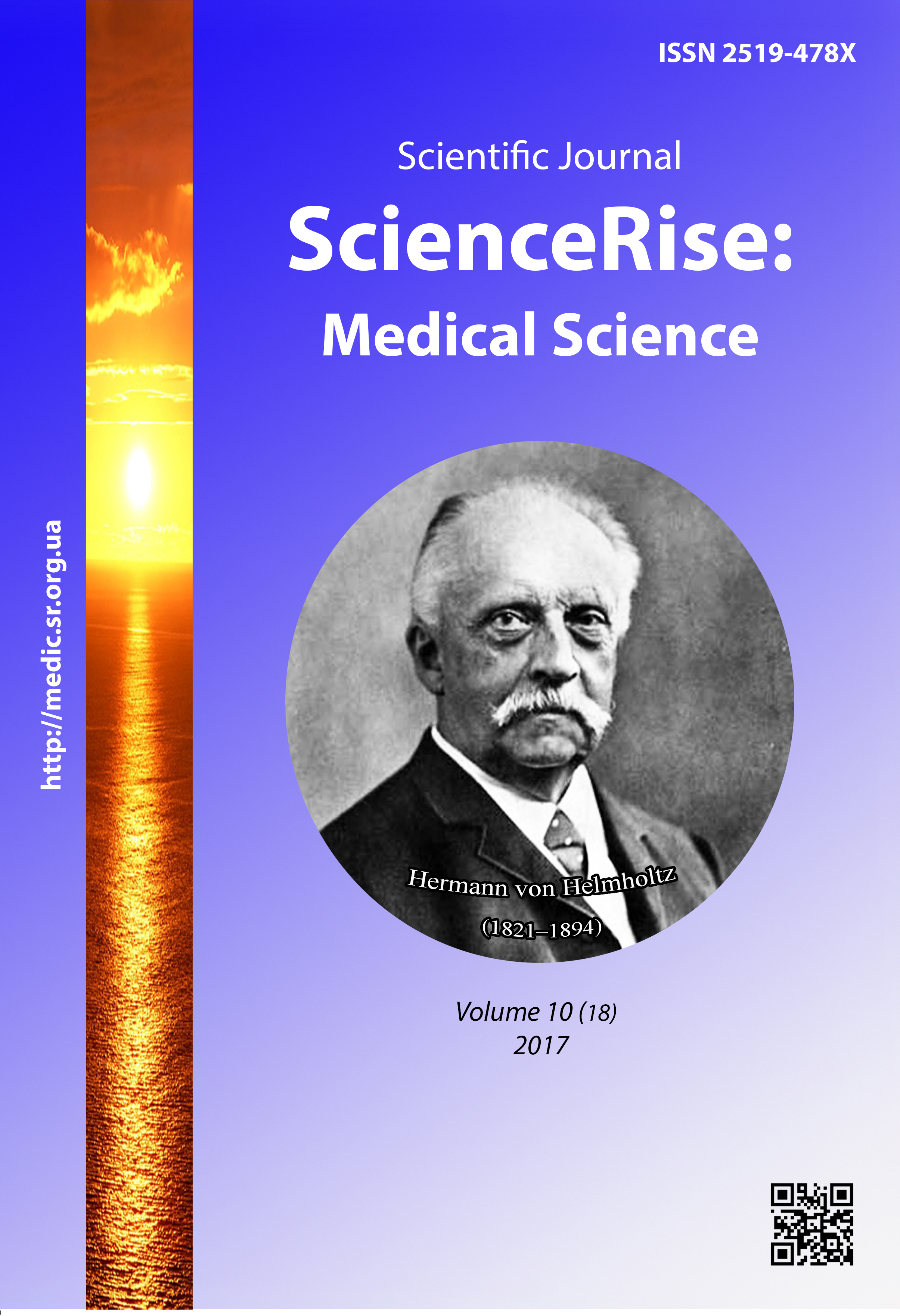Etiological structure of intrauterine infections in pregnant and newborns with a complicated course of the early neonatal period
DOI:
https://doi.org/10.15587/2519-4798.2017.113521Keywords:
intrauterine infections, pregnancy, early neonatal period, mono-infection, mix-infections, clinical symptomsAbstract
Aim of research – the study of the etiological structure of intrauterine infection in pregnant and estimation of their influence on the early neonatal period.
Materials and methods. The material for the study was venous blood of pregnant, umbilical blood, breast maternal milk, mother’s saliva, newborn’s saliva of 114 pairs “mother-newborn”, divided in two groups – control one of physiological course of pregnancy, childbirth and early neonatal period and the main one with clinical symptoms of IUI. The diagnosis was proved by laboratory serological examinations for determining concentrations of IgM to Mycoplasma hominis, Chlamydia trahomatis, Ureaplasma urealyticum, to the herpes simplex virus and concentration and avidity index of specific IgG to HSV, to the virus of 6 type herpes, to the cytomegalovirus. The cytoscopic method was used together with serological ones to diagnose the cytomegaloviral infection.
Research results. The increased concentration of IgM antibodies to M. hominis was revealed in the biological material (venous and umbilical blood) of pairs “woman-newborn) with the complicated course of the neonatal period in 9,1 % of examined persons, in 45,4 % of pairs – IgM to U. urealyticum, and in 81,8 % -to Ch. Trahomatis. IgM to the virus of herpes simplex virus (HVS) were revealed in 19,35 % of samples of venous blood, in 9,67 % of saliva samples and in 6,45 % of samples of breast milk of women; and IgM concentrations to HVS were (0,342±0,06) IU/ml, (0,117±0,04) IU/ml) and (0,438±0,001) IU/ml, respectively. Most samples of the biomaterial included low-avid IgG antibodies to the herpes simplex virus, 76 % of samples of women’s venous blood, 64 % of samples of breast milk and 38,7 % contained low-avid IgG to 6 type herpes virus. The cytomegaloviral infection in this group was diagnosed in 24 % of women and 32 % of newborns. The associated bacterial and viral infection were revealed in 65 % of examined pairs “mother-newborn” with the complicated course of the neonatal period, the triple infection with chlamydias, herpes simplex virus and cytomegalovirus was noted in 14 %; the association of herpes simplex virus, cytomegalovirus and ureaplasma was detected in 5 %. The double chamydia and herpes viral infection of 6 type were observed in 15 % of examined persons, at that these infections were added with ureoplasma in 7 %, with mycoplasma – in 5 %. The mix-infection of urogenital agents – chlamydias and ureaplasma was associated with the cytomegalovirus in 4 % of cases.
Conclusions
1. As a result of the realized study, the diagnosis was confirmed in all newborns with a suspected intrauterine infection.
2. Mix-infections – Chlamydia, associated with viruses of the herpetic group occupy the leading place in the etiological structure of IUI agents, and the neonatal period is most complicated in children with double or triple infection.
3. The leading clinical symptoms in children with IUI are the intrauterine development delay, intrauterine pneumonia, conjugated icterus, conjunctivitisReferences
- Zaplatnikov, A. L., Korovin, N. A., Korneva, M. Yu., Cheburkin, A. V. (2013). Intrauterine infection: diagnosis, treatment, prevention. Emergency medicine, 1, 14–20.
- Tsinzerling, V. A. (2014). Intrauterine infections: modern view upon the problem. Jurnal infektologii, 4, 13–18.
- Anohin, V. A., Haertyinov, H. S., Hasanova, G. R. (2010). Intrauterine infection. Kazan, 96.
- Makarov, O. V., Aleshkin, V. A., Savchenko, T. N. (Eds.) (2009). Infections in obstetrics and gynecology. Moscow: MEDpress-inform, 464.
- Mamyrbayeva, M., Igissinov, N., Zhumagaliyeva, G., Shilmanova, A. (2015). Epidemiological Aspects of Neonatal Mortality Due To IntrauterineInfection in Kazakhstan. Iran J Public Health, 44 (10), 1322–1329.
- Kurmanbayeva, N. N. (2012). Damage of a brain and organs of vision owing to pre-natal infection with a mikst-infection. Vestnik Аlmatinskogo gosudarstvennogo instituta usovershenstvovaniya vrachey, 1, 28–29.
- Lichacheva, A. S., Redko, I. I. (2012). Respiratory virus infections in the structure of antenatal infections of newborns: diagnostics, ways of clinical cource. Tavricheskiy medico-biologicheskiy vestnik, 15 (2), 134–137.
- Lobzin, Yu. V., Vasilev, V. V. (2014). Key aspects congenital infection. Jurnal infektologii, 6, 5–14.
- Buhimschi, I. A., Nayeri, U. A., Laky, C. A., Razeq, S.-A., Dulay, A. T., Buhimschi, C. S. (2012). Advances in medical diagnosis of intra-amniotic infection. Expert Opinion on Medical Diagnostics, 7 (1), 5–16. doi: 10.1517/17530059.2012.709232
- Rooz, R., Gentsel-Borovicheni, O., Prokitte, G. (2013). Neonatology. Practical Recommendations. Moscow: Medical literature, 592.
- Rustamova, M. S., Radzhabova, S. A. (2011). Pregnancy planning in women with the syndrome of pregnancy loss and cytomegalovirus infection. Vestnik poslediplomnogo obrazovaniya v sfere zdravoohraneniya, 4, 39–44.
Downloads
Published
How to Cite
Issue
Section
License
Copyright (c) 2017 Mikola Shcherbina, Lyudmyla Vygivska

This work is licensed under a Creative Commons Attribution 4.0 International License.
Our journal abides by the Creative Commons CC BY copyright rights and permissions for open access journals.
Authors, who are published in this journal, agree to the following conditions:
1. The authors reserve the right to authorship of the work and pass the first publication right of this work to the journal under the terms of a Creative Commons CC BY, which allows others to freely distribute the published research with the obligatory reference to the authors of the original work and the first publication of the work in this journal.
2. The authors have the right to conclude separate supplement agreements that relate to non-exclusive work distribution in the form in which it has been published by the journal (for example, to upload the work to the online storage of the journal or publish it as part of a monograph), provided that the reference to the first publication of the work in this journal is included.









